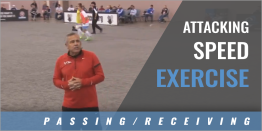| The Power of Possession
Casual soccer fans rally around a team that can pass the ball. It makes sense. There is something intrinsically beautiful about a long run of passes culminating with a three-man combo to an overlapping outside back who puts her serve on the head of a teammate darting in at the near post. It's soccer's answer to the 6-4-3 double play or an alley-oop. Yes, possession is pretty to watch. But if you think that the value of possession is more form than function, you may be missing the boat. Because every time you pass the ball, regardless of the direction your pass goes, you are making progress. The problem is that your players might not realize it. Think of each pass a jab in a heavyweight fight. In the first few rounds those jabs have no discernable effect. The boxers hardly seem to notice them. But each one of those jabs is making a dent – physically and mentally – and in the final three rounds, those jabs start to feel like cannonballs, each one doing slightly more damage than the one before it. You see, it's not about the effectiveness of a single jab. It's about the damage done by the accumulation of those punches. The same applies for passes in a game of soccer. A lot of coaches mix possession drills into their training sessions on a daily basis. And as long as their team is matched up against an inferior opponent, the players can showcase their ability to keep the ball. But when an evenly matched opponent makes it difficult to possess the ball, the players will panic. Those teams will cave to the pressure, quickly abandon their style and end up looking like any other team that has never even considered a possession drill. If your goal is to be a possession team, you've got to commit to it. Possession is a long-term investment and the market isn't always going to be kind to you. You'll have to weather some rough patches. The other team will take the ball from you. That's how soccer works. But if you are a possession team that refuses to abandon its style, over the course of a match you will see your investment start to grow and then snowball. Your team will be better at the end of the game than it was at the beginning. I'll give you an example from a game our team at Georgia played recently. In the first ten minutes we were under siege and struggled to cross midfield. Our opponent was working very hard to smother our short passes and we were barely able to string four passes together. But we are a possession team and we believe in the long haul. So when we couldn't string four passes together, we strung three. And if we couldn't string three, we strung two. But we kept passing the ball. And even those brief runs of possession, if you can accumulate enough of them, will have an effect. Before you knew it our four-pass runs were becoming five, six, and seven-pass runs. The more we passed the ball, the easier it became for us to pass the ball. The easier it became to pass the ball, the more we passed it. The more we passed, the more they chased. And as the half wore on, they began chasing with less conviction. They were growing tired. They were less inspired to chase at a sprint. Imagine being the monkey in a game of Monkey in the Middle with no real hope of being relieved. Your determination to chase would soon deteriorate. Our sustained commitment to passing the ball was having the same effect. With two minutes left in the first half we strung together 22 consecutive passes without our opponent ever touching the ball. The movement concluded with the three-man combo I mentioned above – our left back whipping a cross into the head of our forward. We didn't score on that play, but that run of 22 passes was, for all intents and purposes, a knockout blow. Our opponent was shattered. They had done too much chasing and were out of gas. In the second half they barely touched the ball. We had the run of the park and scored with seven minutes left to win 1-0. That goal was the byproduct of all the passing that led up to it. Jab, jab, jab, goal. Every time you pass the ball, your opponent has to chase it. It's one thing to chase a twenty yard pass once or twice, but imagine having to chase that same pass 15-20 times in a single half – at a sprint. It's tiring. It's demoralizing. It makes for a fatigued and frustrated opponent. And when an opponent is tired and frustrated, that opponent will make mistakes. Players lose their patience and start taking defensive gambles that pull apart their team's defensive shape. Teammates have to compensate for those gambles but they're too tired to do so effectively. Their bodies fail them. Seams open up and chances to score practically create themselves. But you have to commit to the long haul. If I was coaching at the high school level, I would take full advantage of becoming a possession team. At the professional level, possession doesn't have the profound physical impact as it does at the college or high school levels. Professional players are smart enough to be patient. They won't chase all over the field. They don't hit the panic button when their team hasn't touched the ball for 30 seconds. They are disciplined enough to keep their shape and conserve their energy. They know that eventually their team will win the ball back. College players aren't nearly as disciplined and high school players are less disciplined still. String six passes together in a high school game and your opponent's shape will have more holes than a pepper shaker. The challenge is teaching your team to become a possession team. There's no magic wand for that. Players must be schooled in the art of giving great angles of support, passing to the proper foot, receiving with the proper foot, playing simple, playing the way they face, limiting their touches, knowing when to play big or small and everything else that makes it possible to keep possession of the ball. Then again, if your players aren't yet technically competent at passing and receiving, possession is the least of your worries. Some coaches think that possession soccer is bunk. They'll tell you the most effective way to win a game is with a direct style that gets the ball from Point A to Point B as quickly as possible. I'm not going to argue that. There are plenty of teams who do very well playing direct soccer. It's horrendous to watch, but if they're winning, who am I to argue? Still, I prefer to cast my lot with a team that wants to keep the ball. There are two parts to a soccer game – the part where your team has the ball and the part where their team has the ball. It is my elemental belief that when you can elongate the former and reduce the latter, you have a better chance of winning the game. Simple, right? |
|
About the Author... |
|
|
| Dan Blank has been coaching women's college soccer since 1991 and holds an 'A' License from the USSF. He currently serves as assistant coach for the University of Georgia and is the author of the book Soccer IQ, scheduled for release this summer. You can read his blog at www.soccerpoet.com. |







